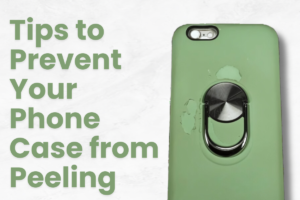We’ve all had it—that heart-stopping instant when your phone falls from your hand and tumbles on the floor. It’s like seeing a slow-motion catastrophe in action. You frantically try to grab it, praying against hope that the screen isn’t broken. But no, there it is—a spiderweb of cracks radiating across the glass, or worse, a huge fracture. Scratches and cracks are the nemesis of phone owners across the globe, and they can destroy the looks and usability of your valued device. Fortunately, there are simple remedies to prevent these feared accidents from happening: screen protectors and phone cases.
In this blog, we’re diving right into the practical solutions to safeguard your phone, keep it looking new, and preserve its value. From selecting the ideal screen protector to learning about the protective strength of phone cases, we’ll see the best equipment for protecting your device.
Why Scratches and Cracks Happen
Let’s take a brief glance at why scratches and cracks happen before we dive into the solutions. Your phone is very much a magnet for trouble. It’s with you 24/7, sliding into key and coin-filled pockets, falling off desks, and going through the weather. Careful or not, normal use inevitably exposes your phone to wear and tear. It doesn’t take much—a bump against a hard edge, a fall from waist level, or even placing your phone screen-down on a dirty surface can cause scratches that appear out of nowhere. Small scratches can gradually compromise the screen’s integrity, causing it to crack eventually.
The good news? You can prevent all that by taking a few precautions.
The Role of Screen Protectors
Screen protectors are a bit like that quiet hero that’s always in the background. They’re ultra-thin transparent layers that cover your phone screen directly to dissipate the toll of daily use. They also serve as your phone’s frontline against scratches, and they will even save it from cracking upon dropping.
Types of Screen Protectors
There are a variety of screen protectors, and the one that you use may make a difference. Here is a breakdown of the two most common ones:
- Tempered Glass Protectors: These provide better protection since they are made to shatter when hit, saving your real screen. Tempered glass protectors are more substantial and offer a far smoother feel, almost like not using any cover on your phone whatsoever. They also deal with scratches like a pro.
- Plastic Film Protectors: If you’re looking for something thinner and more affordable, plastic film protectors might do the trick. They guard against scratches but don’t offer the same level of impact protection as tempered glass. They’re ideal if you want basic protection and prefer a lower profile.
How Screen Protectors Work
Screen protectors do more than just sit there looking transparent. Their main job is to absorb damage. When you accidentally drop your phone or touch it against a rough surface, the protector is the one that takes the brunt of the damage. A good screen protector can take a beating, ranging from slight abrasions to minor impacts, preserving your real phone screen from damage. This is especially true with tempered glass protectors, which distribute and absorb the force of a drop on their surface, minimizing the possibility of your screen breaking.
When to Replace a Screen Protector
Screen protectors aren’t invincible. They get dinged eventually, and a scratched, cracked, or beginning-to-peel protector won’t be of much use. Keep an eye out for obvious signs of wear in the form of cracks or large air bubbles. If your screen protector begins to lose its sharpness or feel less silky-smooth, it’s time for a new one. Most individuals will find they have to replace protectors every 6-12 months, but if you’re prone to accidents, you may need to replace them more often.
The Role of Phone Cases
Now, let’s discuss phone cases—the real protectors of your phone. While screen protectors save your screen, phone cases protect the rest of your phone from bumps, drops, and impacts. A phone case is your best buddy when it comes to maintaining your phone in mint condition.
Different Types of Phone Cases
When you are selecting a phone case, you have choices. Here’s a brief overview of the primary types:
- Hard Cases: Hard cases are constructed of hard materials such as polycarbonate or plastic and provide a firm, protective casing. They’re excellent at withstanding scratches and shielding against small drops, but they might not provide much padding for larger drops.
- Silicone and TPU Cases: These flexible, soft cases are perfect for shock absorption. When you drop your phone, a silicone or TPU case will absorb the impact, distributing it and minimizing the likelihood of cracks or internal damage.
- Hybrid Cases: If you want the best of both worlds, hybrid cases offer both hard outer shells and soft inner linings. They’re designed for maximum protection from drops without making your phone bulky and thick.
Shock Absorption and Drop Protection
The most basic function of a phone case is shock absorption. Materials like silicone and TPU are excellent at doing this because they flex and absorb shock when the phone hits a hard surface. The more flexible and shock-absorbing the case is, the better protected your phone will be against damage. For maximum protection, look for cases with raised bezels around the screen and camera. These edges are bumpers and give protection so that the most delicate parts of your phone aren’t touching the floor.
Ensuring Proper Fit
One of the most commonly overlooked factors when choosing a phone case is fit. A too-loose case won’t stay tightly in place, with room to collect dust and dirt. In contrast, too-tight casing might prevent presses of buttons or accessory ports. Choose a case specifically designed for your model of phone to avoid these issues.
Combining Screen Protectors and Phone Cases for Maximum Protection
While a phone case or screen protector can work alone, together they provide ultimate protection. A screen protector maintains the screen scratch-free, and a case protects the back, edges, and sides from impact. Together, they create an impenetrable shield, protecting your phone from nearly anything life can throw its way.
For those who lead particularly active or adventurous lifestyles, it’s essential to double up. Whether you’re hiking, running, or just prone to the occasional clumsy moment, both a protector and a case are your best bet for keeping your phone intact.
Additional Tips for Preventing Scratches and Cracks
Besides using a screen protector and case, there are a few other tricks to keep your phone looking flawless:
- Don’t leave your phone on rough surfaces. Get into the practice of laying it screen-down or on a cushioned surface.
- Clean your phone regularly so dust and grime don’t scratch it with micro-scratches. Gently wipe it with a soft microfiber cloth.
- Use a phone holder while on the move or driving to minimize drops to zero risk. In case it’s a car mount or a secure location in your bag, holding your phone stationary minimizes the risk of damage.
Conclusion
In today’s world, phones are an extension of ourselves. They’re not just functional—they’re personal statements. Whether you’re sporting funny mobile covers or showing off artistic phone cases, protecting your phone is a must. By combining a high-quality screen protector and a durable phone case, you’ll be able to keep your device safe from scratches, cracks, and everything in between. Don’t wait until it’s too late—invest in protection now, and your phone will thank you!
In today’s world, phones are an extension of ourselves. They’re not just functional—they’re personal statements. Whether you’re sporting funny mobile covers or showing off neon phone cases, protecting your phone is a must. By combining a high-quality screen protector and a durable phone case, you’ll be able to keep your device safe from scratches, cracks, and everything in between. Don’t wait until it’s too late—invest in protection now, and your phone will thank you!







Leave a reply